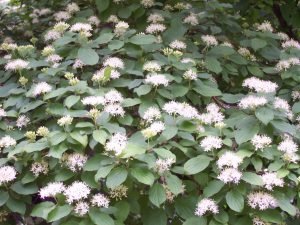
Hello lovely people,
We thought you would find it interesting to provide a more detailed picture of some of the plants we care for and include in our garden schemes, so here’s the first of our specimen-focused blogs for this year.
Today, it’s Cornus

- Cornus is a genus of about 30–60 species of woody plants in the family cornaceae. It is a small to medium broadleaf deciduous shrub with reddish stems and clusters of umbrella-like white flowers that turn to dark berries.
The Cornus or as it’s commonly known as, Dogwood, is a staple feature of many a GreenArt garden scheme. In the summer months when it’s in full leaf it provides a useful backdrop to more showy flowering plants or grasses.
To be honest, from late Spring to Autumn, the dogwood isn’t really anything to shout about. However, by late Autumn, the Cornus comes into its own, bringing much needed colour to otherwise bare beds and borders.
I think my all-time favourite dogwood is the midwinter fire or Cornus sanguinea ‘Midwinter Fire’. And it is not difficult to see how it got its name.

In this scheme at a property that we care for every week, the foliage of these closely packed specimens blends into the green of the orchard pasture to the rear of the border for most of the year, but on a crisp Winter morning the bed is positively ablaze with its bare fiery stems. It really is worth dedicating some space to this shrub if you can.
The origin of the common name ‘dogwood’ comes from the smooth straight twigs, which used to be used to make butchers’ skewers. Skewers used to be called ‘dags’ or ‘dogs’, so the name actually means ‘skewer wood’.
Red Osier Dogwood (Cornus sericea) is prized by basketweavers for the bright burgundy-red bark of its branches which can be harvested for use in weaving.
Whether you fancy growing it to use for weaving or are looking for something to brighten up those beds in the winter months, I can’t recommend the Cornus enough. It is a relatively easy care shrub which makes a great addition to most garden schemes and is also wildlife-friendly too! The leaves are eaten by the caterpillars of some moths, including the case-bearer moth, the flowers are visited by insects and the berries are eaten by many mammals and birds.
As for pruning, if you want to retain a stunning Winter show, then you can cut back the shrub to the ground every Spring. Alternatively, you can keep the structure and thin out the eldest stems by a third. And if you give them a feed and mulch, you should see new stems developing, amidst the foliage, in the summer.
If don’t prune these shrubs, you will notice that the branches thicken and the colour transforms to a dull grey/brown bark. The good news is, that even if you’ve got an overgrown Cornus that hasn’t been pruned for a number of years, then it is still possible to renovate so you can enjoy the colourful stems in the Winter next year.
If you’re not sure where to start with this job, then why not give us a call and we can come over and get you started. Once it is cut back to a more manageable size, it will become much easier to prune the following Spring.
Alternatively, if you are looking to source great Cornus specimens to add to your scheme, that’s something we can also help you with, through our quality suppliers.
Happy Gardening folks,
Jenny
New products in the GreenArt shop
We at GreenArt can provide help at any level
From planning a wildlife garden, building hides, constructing ponds and streams, creating paths and planting trees and shrubs.








